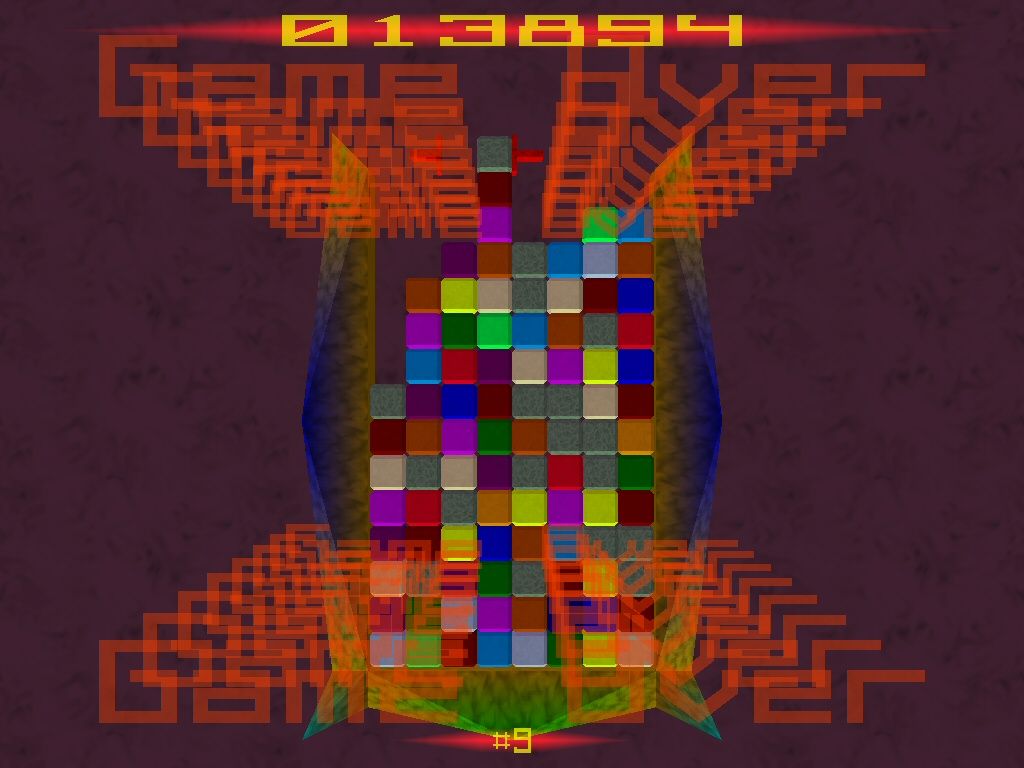Retro Replay Review
Gameplay
Bloxter’s core gameplay revolves around dropping 2×2 energy blocks into a reactor grid and matching numbered energy cells to trigger reactions. Much like the classic Columns, your goal is to align a specified number of identical cells—ranging from two to five—either horizontally or vertically. Every time you complete a match, the energy cells explode out of view, making room for new blocks and fueling potential chain reactions.
(HEY YOU!! We hope you enjoy! We try not to run ads. So basically, this is a very expensive hobby running this site. Please consider joining us for updates, forums, and more. Network w/ us to make some cash or friends while retro gaming, and you can win some free retro games for posting. Okay, carry on 👍)
Each block you drop can be rotated through all four orientations, adding a layer of spatial strategy to every move. Beyond simple matches, Bloxter rewards planning: adjacent cells of the same number but different colors will also trigger when a match occurs next to them, creating satisfying cascade effects. The more reactions you chain together in a single drop, the faster you fill your reaction meter and advance through the level.
The game is divided into five distinct Zones, each containing six reactors with escalating difficulty. As you progress, the required match length increases, bonus items appear (such as drills that remove stubborn cells or special generators that spawn new energy blocks on destruction), and Vanders—hostile creatures like leeches—begin to interfere with your carefully laid plans. Their ability to drain energy cells adds urgency, forcing you to balance offensive matches with defensive play.
With its simple premise, Bloxter unveils surprising depth: each reactor’s layout and obstacle mix demands adaptive tactics. Early levels let newcomers learn the basics, while later stages challenge even seasoned puzzle fans to optimize every drop. Quick reflexes and foresight are both rewarded, making every reactor feel fresh and demanding.
Graphics
Bloxter presents a clean, neon-infused visual style that perfectly suits its high-energy theme. The reactor grid is rendered with crisp lines, while each energy cell glows with a bright, distinctive hue. Color contrasts make it easy to identify numbered cells at a glance, ensuring you can plan matches quickly without squinting or second-guessing.
Animations are smooth and impactful: when cells react, they burst outward with a dynamic particle effect, reinforcing the sense of power you’re unleashing. Chain reactions unleash cascading flares of light, making each successful move feel momentous. Even bonus items and Vanders come alive with subtle motion and shading that communicate their functions instantly.
The user interface remains unobtrusive, with minimal panels showing your current match requirements, reaction count, and any active power-ups. Transitions between reactors employ quick fade-ins and framing animations, preserving the game’s brisk pace. Overall, Bloxter’s visual presentation is both functional and stylish, ensuring you stay immersed in the reactor’s pulsing energy.
Story
While Bloxter is primarily a puzzle experience, it wraps its challenges in a light sci-fi narrative. You assume the role of a reactor engineer in a facility on the brink of overload. Your mission is simple yet critical: stabilize each reactor by initiating controlled energy cell reactions before the core destabilizes.
Between Zones, brief text interludes sketch the stakes—overloading reactors, mysterious Vanders threatening system integrity, and the promise of unlocking deeper sections of the facility. Though the storyline never veers into epic territory, it provides enough context to make every puzzle feel like a mission rather than a standalone brain teaser.
Characterization is minimal but effective: your avatar, the unseen operator, conveys determination through audio cues and reactor status alerts. Enemies like leeches, pulsars, and other Vanders carry evocative names that bring personality to what could otherwise be purely abstract block-matching. This light narrative framework adds motivation to each level without bogging down the gameplay.
Overall Experience
Bloxter strikes a satisfying balance between arcade-style immediacy and methodical puzzle depth. Its intuitive controls and clear visuals make it accessible for newcomers, while the layered mechanics—bonus items, chain reactions, and enemy interference—offer plenty of challenge for veterans. Matches feel varied thanks to the five Zones and the distinct obstacles each reactor presents.
Replayability is strong: goals like high chain counts, speed runs, and strategic use of special items invite you to revisit earlier reactors with fresh objectives. The pacing keeps sessions engaging, whether you have five minutes to spare or want to settle in for an extended play session. The lack of overly long cutscenes ensures your focus remains on the reactor grid and the thrill of cascading energy reactions.
On the downside, players seeking a deep narrative or character progression may find the story lightweight. Additionally, the introduction of Vanders can sometimes feel punitive, especially on higher difficulties where timing mistakes are less forgiving. However, these challenges largely enhance the game’s tension rather than detract from the core puzzle fun.
All told, Bloxter offers a compelling puzzle package that feels both familiar and fresh. Its blend of strategic block placement, vibrant visuals, and incremental challenges make it a strong recommendation for fans of tile-matching and reaction-based puzzles. If you’re ready to dive into a reactor grid and unleash a chain of explosive energy reactions, Bloxter is a bright, addictive choice.
 Retro Replay Retro Replay gaming reviews, news, emulation, geek stuff and more!
Retro Replay Retro Replay gaming reviews, news, emulation, geek stuff and more!









Reviews
There are no reviews yet.